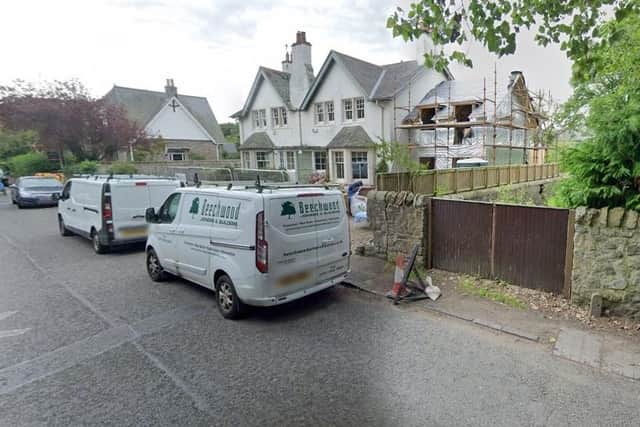Edinburgh residents fight against double yellow lines at care home
and live on Freeview channel 276
Edinburgh residents fighting to have double yellow lines removed from a village road say they have resulted in motorists driving faster.
Locals in Cramond also accused the council of using the parking restrictions as a “smokescreen” to facilitate the construction of a new care home and said an exit on to the road from the development would not allow drivers sufficient visibility.
Advertisement
Hide AdAdvertisement
Hide AdThe lines were first painted after the care home was granted permission back in 2016, with planners telling developers residents couldn’t move in until parking and loading restrictions were fully implemented by the entrance at the junction of Whitehouse Road and School Brae, and at the proposed exit on to Cramond Glebe Road.


The council said the changes are needed “to ensure adequate visibility is afforded to drivers exiting,” adding without them the junction would be “unsafe”.
However, angry villagers have argued the double yellow lines do not have the desired effect and said drivers now go faster along Cramond Glebe Road as there are no cars in the way.
Residents also highlighted loss of parking as an issue and called for the restrictions to be removed at the care home exit as they made the case against the council’s Traffic Regulation Order (TRO) being made permanent at a hearing chaired by a Scottish Government planning reporter on Wednesday (October 19).
Advertisement
Hide AdAdvertisement
Hide AdThe hearing, which was initially due to be held in 2020 but was postponed following the Coronavirus outbreak, was triggered after the council received over 150 objections to the TRO.
Madeleine Graham from Cramond Action Group (CAG), which also opposed the care home plans, said cars have gone “at much greater speeds up and down the road” since the lines were painted.
“Before you couldn’t see where you were going, now you can because you’ve got from the entrance to Cramond Glebe Road right down to the bit going off to Cramond Terrace to speed down. The traffic is now much faster,” she said.
Ms Graham said motorists now travel at “nearer 40 miles an hour than 20”, adding there is next to no enforcement of the new parking restrictions by the council.
Advertisement
Hide AdAdvertisement
Hide AdFellow CAG member Sally Watt echoed her remarks, saying: “Speeding has definitely increased since the double yellow lines were put there.
“There’s a lot of visitors to the car park at the esplanade who are not familiar with the road.”
Whilst acknowledging drivers “tend to drive faster” in the absence of parked cars, Edinburgh Council transport manager Dave Sinclair said the conditions still make for a “safer environment” as visibility is improved.
But the group’s main concern was with the proposed care home exit, which it emerged would not meet the council’s own design guidance for junctions.
Advertisement
Hide AdAdvertisement
Hide AdMs Watt added: “I’ve been taking my car out of our drive (on Cramond Glebe Road) for over 20 years – you cannot see what is on the road until you are on the road so I can’t see how the council can say the visibility is adequate, it just isn’t.”
A statement released by CAG ahead of the hearing argued the “true end” of the TRO is “the facilitation of the construction of the care home” which the council denied.
“The supposed traffic improvements at Cramond Glebe Road are a smokescreen designed to obscure the council’s true purpose,” it said.
“The council has painted itself into a corner. The council knows that the proposed exit is materially and inherently unsafe, that major work is required to make the exit safe.
Advertisement
Hide AdAdvertisement
Hide Ad“The TRO in isolation will do nothing to bring the exit up to acceptable and contemporary standards of visibility.”
The group accused the council of a “lack of honesty” and called for the TRO to be “struck down,” adding the disadvantages and risks associated with the scheme “far outweigh any notional or abstract benefits”.
Ms Graham said: “I can’t see how the council can accept the visibility displays are going to be sufficient and I don’t think in any event double yellow lines will help with visibility.”
But Mr Sinclair said the yellow lines on the road, including those at the controversial junction, would give drivers “roughly a clear line of sight once you are beyond and the driver is onto the pavement”.
Advertisement
Hide AdAdvertisement
Hide Ad“The measures, both in terms of the restrictions and the prohibitions, are designed to operate collectively,” he added.
Meanwhile, Cramond and Barnton Community council (CBCC) also attended to object.
In a statement the group said members are “broadly supportive of parking and loading restrictions applied to Cramond Glebe Road – with the exception of those introduced at the exit from the proposed care home”.
“We contend that not only will the TRO not create safe conditions in this area for pedestrians and motor vehicles, but in relation to the use of Cramond Glebe Road by cyclists, it will increase danger.”
Advertisement
Hide AdAdvertisement
Hide AdCommunity councillor John Howison said: “This traffic order is not going to ensure adequate visibility is afforded to drivers and therefore it cannot be regarded as a suitable traffic order.
“Because of the deficiency of this junction it is impossible for drivers to ensure they are safe when they make the manoeuvre approaching that junction, they are doing it completely blind effectively.”
Planning Reporter Andrew Fleming is now set to review the case and issue a decision on whether the restrictions will remain.